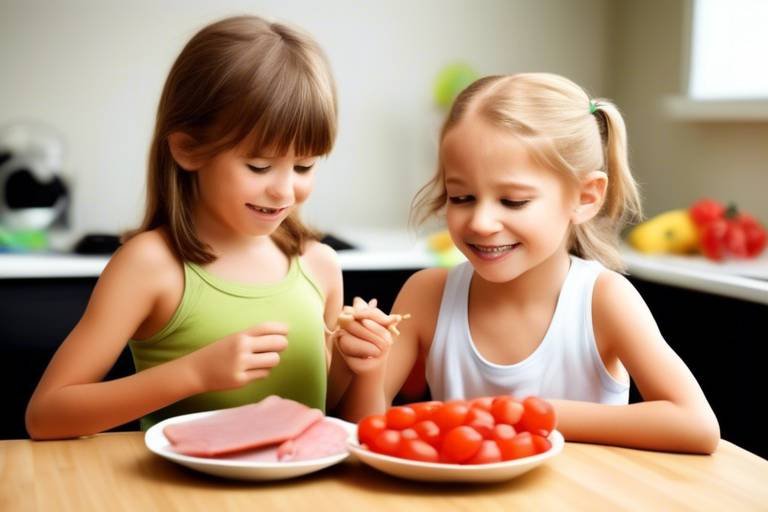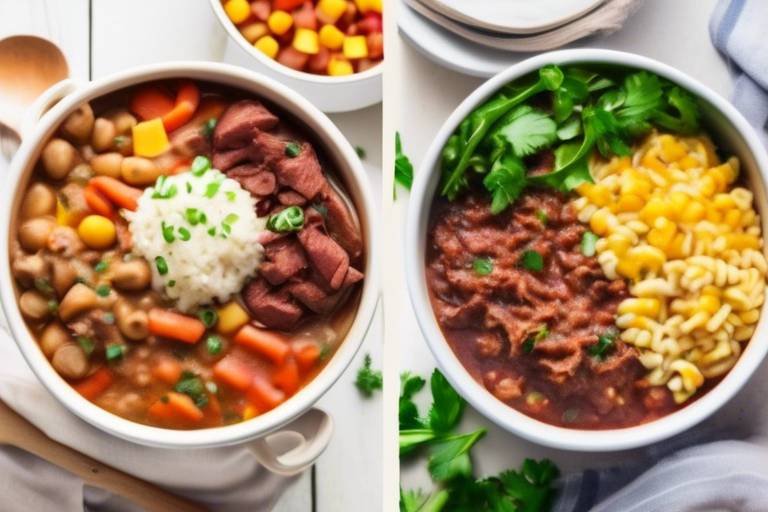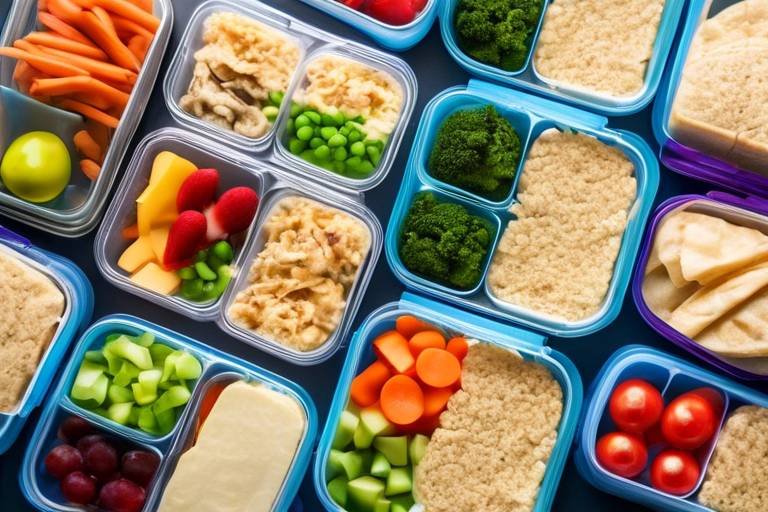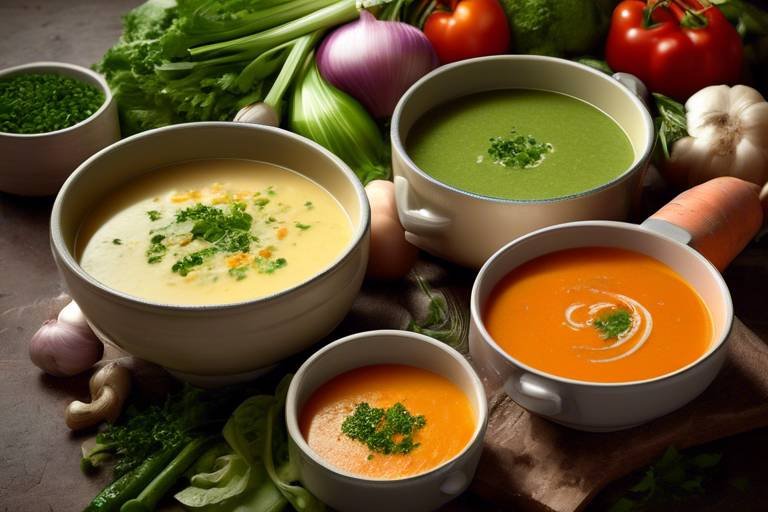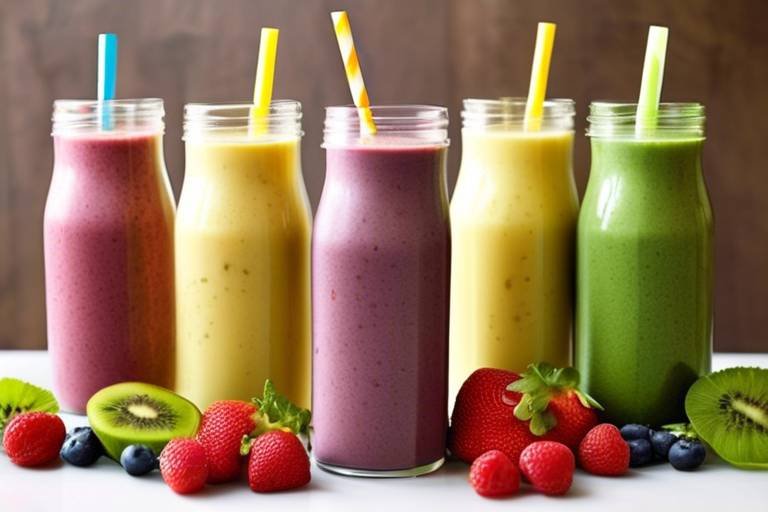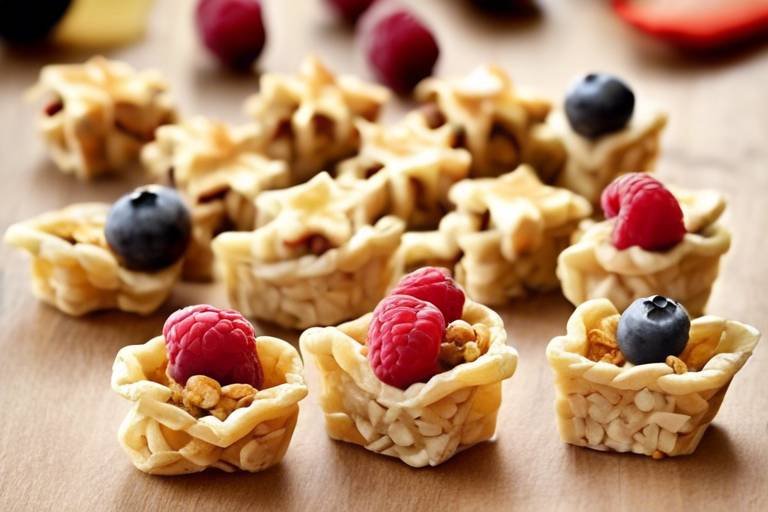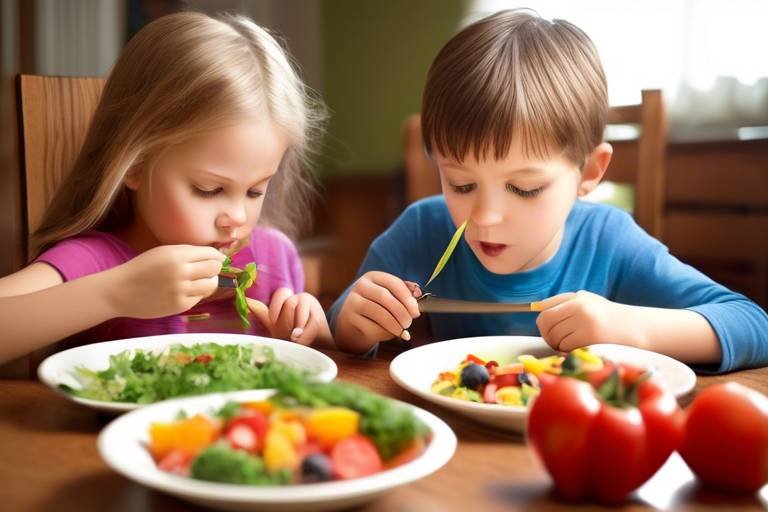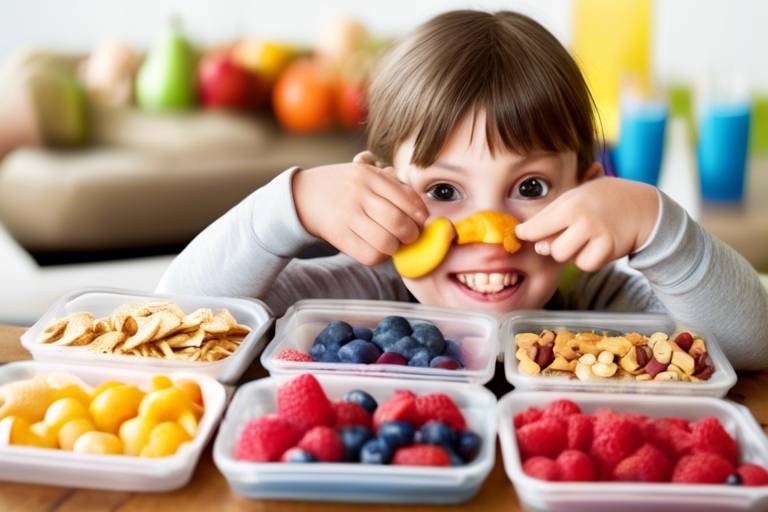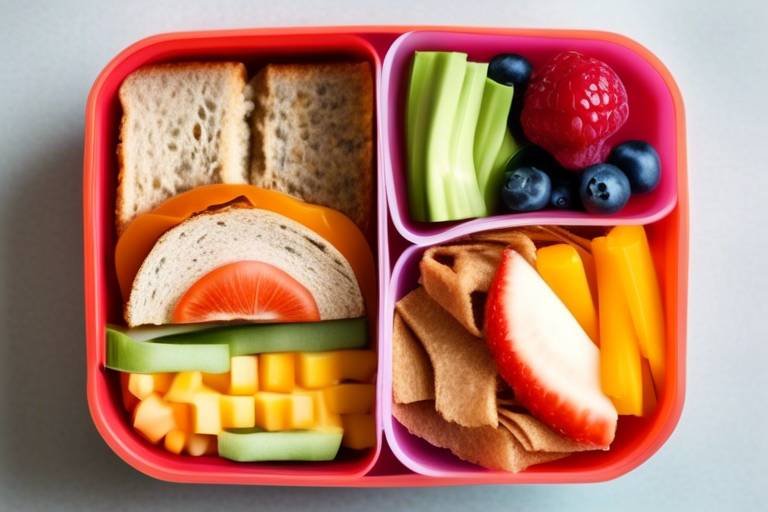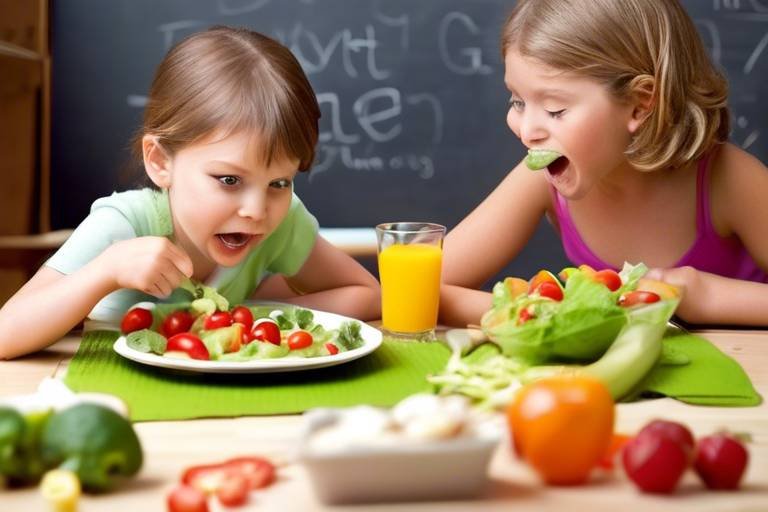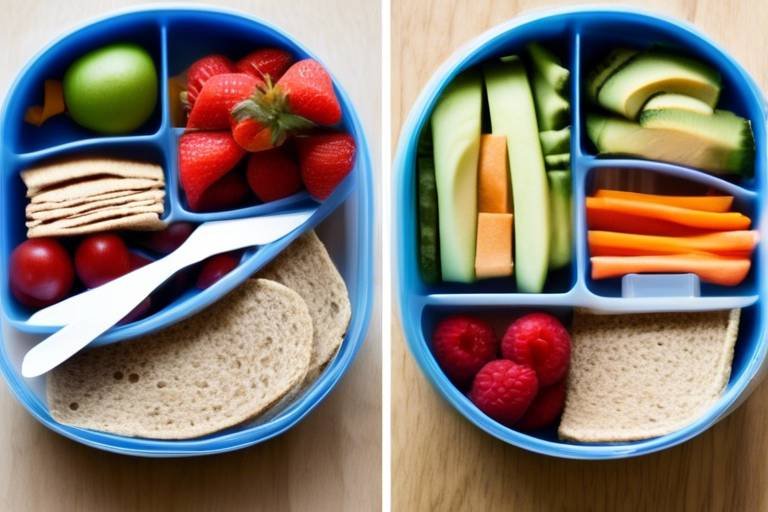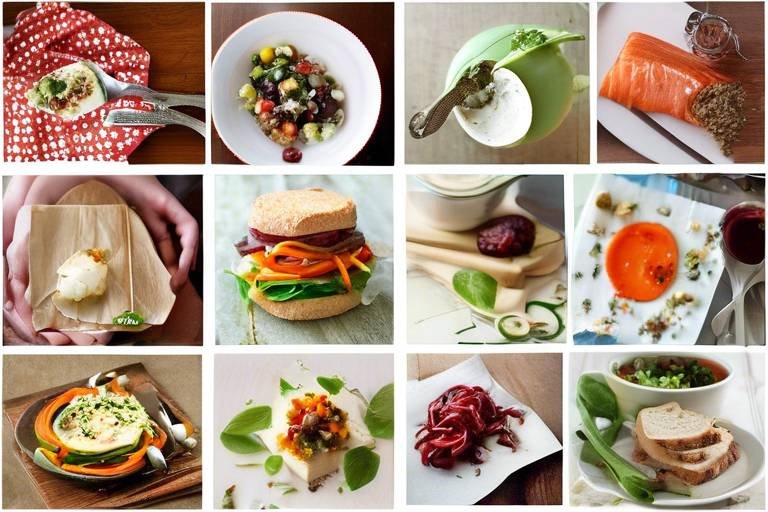5 Quick and Healthy Snacks for Kids
This article explores five nutritious snack options that are easy to prepare and perfect for kids. These snacks will keep them energized and satisfied between meals while promoting healthy eating habits. As parents, we often find ourselves in a snack-time dilemma: how do we satisfy our little ones' cravings while ensuring they're munching on something healthy? Fear not! These delightful snacks are not only delicious but also packed with essential nutrients, ensuring your kids get the best of both worlds. Let’s dive into these quick and healthy snack ideas that will have your kids asking for more!
A delicious combination of fresh fruits and yogurt, this parfait is not only visually appealing but also packed with vitamins and probiotics, making it a perfect snack for kids. Imagine a colorful layer of vibrant berries, creamy yogurt, and crunchy granola all in one cup! This snack is like a mini dessert that’s actually good for them. You can easily customize it with your child's favorite fruits. Plus, it’s a fantastic way to sneak in some dairy and fiber. Just grab a few ingredients, layer them up, and you've got yourself a snack that looks as good as it tastes!
Crunchy vegetable sticks paired with creamy hummus provide a satisfying and nutritious snack, encouraging kids to enjoy their veggies while benefiting from fiber and protein. It’s like giving them a colorful rainbow on their plate! Kids are often more inclined to eat their veggies when they can dip them into something delicious. Hummus is not only tasty but also a great source of plant-based protein. When you present this snack, make it fun! Use cookie cutters to create exciting shapes or arrange the veggies in a fun pattern on the plate.
Selecting colorful vegetables like carrots, cucumbers, and bell peppers makes this snack more enticing for kids, ensuring they get a variety of nutrients. Think of it as a vibrant garden on their plate! The more colors, the more nutrients they’re consuming. You can even involve your kids in the selection process at the grocery store. Let them pick out their favorite veggies to create a personalized veggie platter!
Experimenting with different flavors of hummus, such as roasted red pepper or garlic, can keep this snack exciting and appealing to children. Why stick to plain when you can have a flavor explosion? Each dip can be a new adventure for their taste buds!
Presenting veggie sticks and hummus in fun shapes or colorful plates can enhance the snack experience and encourage kids to eat healthier. A simple change in presentation can make a world of difference. Try using a divided plate to keep things organized and visually appealing!
Hummus is rich in protein and healthy fats, making it a filling option that helps support kids' growth and development. It’s like a superhero for their snacks! Not only does it taste great, but it also fuels their little bodies with the energy they need for all their adventures.
These simple bites combine the sweetness of bananas with the creaminess of peanut butter, providing a tasty treat that’s high in potassium and healthy fats. Imagine biting into a soft banana slice smeared with rich peanut butter – pure bliss! It’s a snack that feels indulgent but is packed with nutrients. You can even roll them in crushed nuts or seeds for an added crunch. It’s a snack that’s sure to please even the pickiest of eaters!
For kids with nut allergies, alternatives like sunflower seed butter can be used, ensuring everyone can enjoy this nutritious snack. This way, no one feels left out, and they still get to enjoy that creamy goodness!
Adding toppings like granola or chocolate chips can make peanut butter banana bites even more appealing to picky eaters. It’s all about making it fun and exciting! You can even turn this into a mini cooking session with your kids – let them sprinkle on their favorite toppings!
Combining cheese with whole grain crackers offers a balanced snack rich in calcium and fiber, perfect for keeping kids full and satisfied. This classic combo is like a match made in snack heaven! Cheese provides the calcium they need for strong bones, while whole grain crackers add that much-needed fiber. It’s a win-win!
Opting for low-fat cheese varieties can provide the same delicious taste while reducing saturated fat intake for healthier snacking. There are so many options out there – from string cheese to cheese slices – that can make snack time fun and nutritious.
Using cookie cutters to create fun shapes with cheese and crackers can make this snack more visually appealing and exciting for kids. Who wouldn’t want to eat a star-shaped cheese slice? It’s all about making healthy eating enjoyable!
These no-bake energy balls made with oats, honey, and nut butter are perfect for a quick snack, providing sustained energy for active kids throughout the day. They’re like little power-packed bites of goodness! You can whip them up in no time and store them in the fridge for an easy grab-and-go option. They’re perfect for busy days when you need something nutritious and quick!
Parents can customize energy balls by adding ingredients like dried fruits, seeds, or chocolate chips, making them a versatile snack option. Let your kids help in the kitchen and choose their favorite mix-ins. It’s a fun way to get them involved in healthy eating!
Properly storing energy balls in the refrigerator can keep them fresh and ready for a quick grab-and-go snack anytime. Just pop them in a container, and you’ve got healthy snacks ready for the week!
A fun and refreshing treat, frozen yogurt bark topped with fruits and nuts is a healthy alternative to ice cream that kids will love. It’s like a canvas for creativity! You can spread yogurt on a baking sheet, sprinkle on your favorite toppings, and freeze it. Once it’s set, just break it into pieces, and voila – a delightful snack that’s as fun to make as it is to eat!
Creating yogurt bark is simple and allows for creativity, as kids can choose their favorite toppings for a personalized snack. This is a great opportunity to introduce them to a variety of fruits and nuts, expanding their palate while having a blast!
Yogurt is an excellent source of probiotics, calcium, and protein, making it a nutritious choice for growing children. It’s like giving their tummy a healthy boost with every bite!
Q: Are these snacks suitable for school lunches?
A: Absolutely! These snacks are portable and easy to pack, making them perfect for school lunches.
Q: Can I prepare these snacks in advance?
A: Yes! Many of these snacks can be made ahead of time and stored for convenience.
Q: How can I get my kids to try these snacks?
A: Involve them in the preparation process and make it a fun activity. Kids are more likely to try snacks they helped make!
Fruit and Yogurt Parfait
A is a delightful and nutritious snack that can easily win over even the pickiest of eaters. Imagine layers of creamy yogurt, sweet fruits, and crunchy toppings all coming together to create a visual feast that’s as appealing to the eyes as it is to the taste buds! Not only does this snack look amazing, but it also packs a powerful nutritional punch. With a combination of vitamins from fresh fruits and probiotics from yogurt, it’s a snack that promotes healthy digestion and boosts the immune system.
To prepare a parfait, you can start with a base of plain or flavored yogurt—Greek yogurt is a fantastic option due to its high protein content. Then, add layers of colorful fruits such as strawberries, blueberries, and bananas. These fruits are not only delicious but also rich in essential vitamins and minerals. The vibrant colors can make the parfait visually appealing, which is crucial for enticing kids to dig in.
Why not take it a step further and add some crunch? A sprinkle of granola or nuts can provide that satisfying texture contrast while also adding fiber and healthy fats to the mix. You can create a custom parfait by letting your kids choose their favorite fruits and toppings. This not only encourages them to eat healthier but also gives them a sense of ownership over their food choices.
Here's a simple way to layer your parfait:
| Layer | Ingredients |
|---|---|
| Base | Yogurt (Greek, plain, or flavored) |
| First Layer | Fresh fruits (strawberries, blueberries, bananas) |
| Second Layer | Granola or nuts |
| Top Layer | More fruit and a drizzle of honey (optional) |
In addition to being a quick and easy snack, a fruit and yogurt parfait can also be a fun activity for the whole family. You can set up a parfait bar where everyone can create their own version. This not only makes snack time more interactive but also encourages kids to try new fruits and toppings they might not usually eat. Plus, it’s a great way to sneak in some extra nutrition!
So next time you’re looking for a snack that’s both healthy and appealing, consider whipping up a fruit and yogurt parfait. It’s a versatile option that can be enjoyed any time of day—whether it’s for breakfast, an afternoon snack, or even dessert. With so many combinations to choose from, you’ll never run out of ways to keep it exciting!
Veggie Sticks with Hummus
Crunchy vegetable sticks paired with creamy hummus provide a satisfying and nutritious snack, encouraging kids to enjoy their veggies while benefiting from fiber and protein. Imagine a vibrant plate filled with colorful carrots, cucumbers, and bell peppers, all waiting to be dipped into a smooth, flavorful hummus. This combination not only delights the taste buds but also packs a powerful punch of nutrients, making it a fantastic option for kids who might be skeptical about eating their greens. The creamy texture of the hummus complements the crispness of the veggies, creating a delightful contrast that keeps kids coming back for more.
Selecting colorful vegetables like carrots, cucumbers, and bell peppers makes this snack more enticing for kids, ensuring they get a variety of nutrients. When you present a rainbow of veggies, it’s not just about looks; it’s about providing a spectrum of vitamins and minerals that help support their growth and development. You might even consider adding some less common options like snap peas or radishes to keep things interesting. The crunch of these fresh veggies can be incredibly satisfying, and when paired with hummus, they become a fun, interactive snack that encourages kids to explore new flavors and textures.
Experimenting with different flavors of hummus, such as roasted red pepper or garlic, can keep this snack exciting and appealing to children. Hummus is incredibly versatile; you can easily whip up a batch at home or find pre-made options in stores. By introducing various flavors, you can cater to your child's preferences and perhaps even sneak in some extra nutrients. For instance, adding spinach or beets to your hummus not only enhances its nutritional profile but also gives it a fun color that might just entice your little ones to try something new!
Presenting veggie sticks and hummus in fun shapes or colorful plates can enhance the snack experience and encourage kids to eat healthier. Consider using cookie cutters to create star or heart-shaped veggie sticks, or serve the hummus in a vibrant bowl that catches their eye. You can even create a small “veggie garden” on the plate, arranging the sticks like flowers in a pot. The more engaging and visually appealing you make the snack, the more likely kids will be excited to dig in. Remember, making healthy eating fun is a key ingredient in promoting lifelong healthy habits!
Hummus is rich in protein and healthy fats, making it a filling option that helps support kids' growth and development. Packed with chickpeas, tahini, and olive oil, hummus provides essential nutrients that fuel their active lifestyles. Not only does it keep hunger at bay, but it also supports brain health and energy levels, allowing kids to stay focused and energized throughout their day. Plus, the fiber content in hummus promotes digestive health, making it a snack that truly checks all the boxes for parents looking to nourish their children.
Q: Can I make hummus at home?
A: Absolutely! Making hummus at home is easy and allows you to customize the flavors to your liking. Simply blend chickpeas, tahini, olive oil, lemon juice, and garlic until smooth. Feel free to experiment with different spices and ingredients!
Q: What are some other veggie options I can use?
A: Besides carrots, cucumbers, and bell peppers, you can try celery sticks, cherry tomatoes, radishes, or even broccoli florets. The goal is to keep it colorful and appealing!
Q: Is hummus a good source of protein?
A: Yes, hummus is a great source of plant-based protein, making it an excellent choice for growing kids who need adequate nutrition for their development.
Choosing the Right Veggies
When it comes to snacking, can make all the difference in enticing kids to munch on something healthy. Kids are naturally drawn to bright colors and interesting shapes, so picking a variety of vegetables that are visually appealing is key. Think about incorporating a rainbow of colors onto their plates! For instance, you can include carrots, cucumbers, and bell peppers, which not only provide a burst of color but also a range of nutrients.
Each vegetable brings its own unique set of benefits. Carrots are rich in beta-carotene, which is great for eye health, while cucumbers are hydrating and low in calories, making them perfect for a light snack. Bell peppers, especially the red and yellow varieties, are packed with vitamin C, which is essential for a strong immune system. By mixing these veggies, you create a snack that is both nutritious and visually enticing, encouraging kids to dive in!
To make the veggie sticks even more appealing, consider cutting them into fun shapes or pairing them with a tasty dip like hummus. This not only adds flavor but also makes the experience of eating veggies more enjoyable. You can even create a colorful veggie platter that turns snacking into a fun activity. Remember, the more engaging the presentation, the more likely kids are to try new vegetables!
Here’s a quick table summarizing some great veggie options and their health benefits:
| Vegetable | Health Benefits |
|---|---|
| Carrots | Rich in beta-carotene for eye health |
| Cucumbers | Hydrating and low in calories |
| Bell Peppers | Packed with vitamin C for immune support |
| Celery | Low-calorie and high in fiber |
| Cherry Tomatoes | Rich in antioxidants and vitamins |
In summary, when it comes to choosing the right veggies, focus on variety, color, and fun presentation. This approach not only promotes healthy eating habits but also turns snacking into a delightful experience for kids!
Q: How can I encourage my kids to eat more vegetables?
A: Get creative with presentations, involve them in the preparation process, and pair veggies with tasty dips to make them more appealing!
Q: Are there any veggies that are particularly good for kids?
A: Yes! Carrots, bell peppers, cucumbers, and cherry tomatoes are all great choices due to their taste, texture, and health benefits.
Q: What if my child doesn’t like certain vegetables?
A: Keep trying! Sometimes it takes several attempts before kids develop a taste for certain veggies. You can also try different cooking methods or incorporate them into smoothies.
Hummus Variations
Hummus is a wonderfully versatile snack that can be easily customized to suit your child's taste buds. While traditional hummus made from chickpeas, tahini, lemon juice, and garlic is delicious on its own, experimenting with different flavors can make this healthy dip even more exciting. Imagine transforming a simple snack into a culinary adventure, where every bite offers a new flavor explosion!
Here are some fun and tasty that you can try:
- Roasted Red Pepper Hummus: This variation adds a sweet and smoky flavor, making it a favorite among kids. The vibrant color also makes it visually appealing!
- Garlic Hummus: For those who love a strong flavor, adding extra garlic can create a zesty kick. Just be cautious, as not all kids are fans of garlic!
- Avocado Hummus: Blending ripe avocados into hummus not only enhances the creaminess but also adds healthy fats. This green delight is sure to please!
- Beet Hummus: For a striking pink dip, blend in some cooked beets. This not only adds a unique flavor but also boosts the nutritional profile with additional vitamins.
- Spicy Hummus: For older kids who enjoy a little heat, incorporating jalapeños or a pinch of cayenne pepper can spice things up!
These variations can be easily made at home, and kids can even help in the kitchen, making it a fun bonding activity. Encourage them to choose their favorite ingredients and create their own signature hummus blend. You might be surprised by what they come up with!
Additionally, serving hummus with a variety of colorful dippers like carrot sticks, cucumber slices, or whole-grain pita chips can make snack time more enticing. The visual appeal of a rainbow of veggies paired with hummus can turn a simple snack into a feast for the eyes and palate. It’s all about making healthy eating a fun and interactive experience!
Serving Suggestions
When it comes to making veggie sticks and hummus a hit with kids, presentation is everything! Kids are naturally drawn to colorful and fun arrangements, so why not get creative? One idea is to use a variety of colorful plates to serve the snacks. Bright red, blue, and yellow plates can turn a simple snack into a vibrant feast. You could even use cookie cutters to shape the veggie sticks into fun characters or animals. Imagine a plate of carrot sticks shaped like stars or cucumber slices resembling flowers! This not only makes the snack more visually appealing but also encourages kids to engage with their food.
Another fun serving suggestion is to create a dipping station. Set up a small platter with different types of hummus, like classic, roasted red pepper, and garlic, alongside a rainbow of veggie sticks. This allows kids to experiment and discover their favorite flavors. You could even provide small dipping cups for each child, making it a fun, interactive experience. If you want to take it a step further, consider adding a few whole-grain pita chips or whole grain crackers to the mix. This not only adds variety but also helps to balance the snack with some whole grains.
Lastly, don’t underestimate the power of themed snack days. For example, you could have a 'Rainbow Day' where kids are encouraged to eat something from each color of the rainbow. This promotes healthy eating habits while also making it an enjoyable activity. Pairing the snacks with a fun story or a short educational segment about the benefits of eating veggies can also make the experience more enriching. After all, when kids are involved in the preparation and presentation of their food, they are more likely to try new things and develop a love for healthy eating!
Here are some common questions parents might have regarding healthy snacks for kids:
- What are some other healthy snack options? In addition to veggie sticks and hummus, consider fruits with nut butter, yogurt with granola, or whole grain popcorn.
- How can I get my kids to eat more vegetables? Try involving them in the cooking process or serving veggies with a fun dip like hummus or yogurt-based dressings.
- Are there any nut-free alternatives for snacks? Absolutely! Sunflower seed butter or pumpkin seed butter can be great substitutes for nut butter.
- How can I make snacks more appealing? Use colorful plates, fun shapes, and involve kids in the preparation to make snacks more exciting.
Health Benefits of Hummus
Hummus is more than just a tasty dip; it's a nutritional powerhouse that can provide numerous health benefits for kids. Made primarily from chickpeas, tahini, and olive oil, this creamy delight is packed with essential nutrients that support children's growth and development. One of the standout features of hummus is its high protein content, which is crucial for building and repairing tissues in growing bodies. Additionally, hummus is a fantastic source of fiber, which aids in digestion and helps keep little tummies satisfied between meals.
Moreover, hummus contains healthy fats, particularly from olive oil and tahini, which are important for brain health. The unsaturated fats found in these ingredients can help improve cognitive function and support overall brain development. What’s more, hummus is rich in vitamins and minerals, including:
- Iron - Essential for transporting oxygen in the blood.
- Folate - Important for cell division and growth.
- Magnesium - Supports muscle and nerve function.
- Vitamin B6 - Vital for protein metabolism and cognitive development.
Incorporating hummus into your child's diet can also encourage them to eat more vegetables. When paired with colorful veggie sticks, it transforms healthy eating into a fun and tasty experience. Kids are more likely to munch on carrots, celery, and bell peppers when they have a delicious dip to accompany them. This not only helps them consume more nutrient-dense foods but also fosters a positive relationship with healthy eating habits from a young age.
In summary, hummus is a versatile and nutritious snack that can be easily included in your child's diet. Whether spread on whole grain bread, served with veggie sticks, or even used as a salad dressing, the health benefits of hummus are undeniable. It’s a simple yet effective way to enhance your child's nutrition while keeping snack time exciting!
Q: Is hummus suitable for kids with nut allergies?
A: Absolutely! Hummus is typically made from chickpeas and does not contain nuts, making it a safe option for children with nut allergies. Just ensure that the tahini used is also nut-free.
Q: How can I make hummus more appealing to my kids?
A: You can add fun flavors to hummus, such as roasted red pepper, garlic, or even a hint of chocolate for a sweet twist. Presenting it with colorful vegetable sticks or whole grain pita chips can also make it more enticing!
Q: Can hummus be part of a balanced diet for kids?
A: Yes, hummus can be a healthy addition to a balanced diet. It provides protein, fiber, and healthy fats, making it a great option for snacks or as part of a meal.
Peanut Butter Banana Bites
These simple yet delightful are a fantastic way to combine the natural sweetness of bananas with the creamy richness of peanut butter. Not only are they incredibly easy to prepare, but they also pack a powerful nutritional punch! Bananas are loaded with potassium, which is essential for maintaining healthy muscle function and promoting heart health. When paired with peanut butter, which is rich in healthy fats and protein, this snack becomes a satisfying option that will keep your kids energized and ready to tackle their day.
To make these tasty bites, simply slice a banana into thick rounds and spread a generous layer of peanut butter on one side of each slice. You can even sandwich two banana slices together for a fun twist! But why stop there? This snack can be easily customized to cater to your child's taste preferences. Here are some creative variations you might consider:
- Nut Butter Alternatives: If your little one has nut allergies, don't worry! You can use alternatives like sunflower seed butter or soy nut butter. These options still provide a delicious flavor and maintain the nutritional benefits.
- Creative Toppings: Consider adding a sprinkle of granola for extra crunch or a few mini chocolate chips for a hint of sweetness. You can even drizzle a little honey on top for an added touch of sweetness.
These are not just a tasty snack; they also make for a fantastic after-school treat or a quick breakfast option. You can prepare them in advance and store them in the refrigerator, making it easy for your kids to grab a healthy snack on the go. Plus, they are visually appealing, which can encourage even the pickiest eaters to give them a try!
When it comes to serving, you can get creative! Present these bites on a colorful plate or arrange them in fun shapes. The more inviting they look, the more likely your kids will want to munch on them. And let's face it, who doesn't love a little bit of fun with their food?
In summary, are not only quick and easy to prepare but also provide a nutritious boost to your child's day. With their delightful combination of flavors and textures, they are sure to be a hit in your household!
Q: Can I use other fruits besides bananas?
A: Absolutely! You can try using apple slices, strawberries, or even pears. Just keep in mind that the texture and flavor will change slightly.
Q: How long do these bites last in the fridge?
A: They typically last about 2-3 days in the refrigerator. However, it's best to consume them fresh for optimal taste and texture.
Q: Are there any other healthy toppings I can use?
A: Yes! You can try using chia seeds, shredded coconut, or even a sprinkle of cinnamon for added flavor and nutrition.
Nut Butter Alternatives
When it comes to delicious and nutritious snacks for kids, nut butters like peanut butter are often a favorite. However, for parents of children with nut allergies, finding alternatives can be a bit of a challenge. Thankfully, there are several that are just as tasty and packed with nutrients. These alternatives ensure that every child can enjoy a satisfying snack without the worry of allergic reactions.
One of the most popular alternatives is sunflower seed butter. Made from ground sunflower seeds, this creamy spread is not only nut-free but also rich in vitamins and minerals. It's a great source of vitamin E, which is essential for healthy skin and eyes. Plus, its flavor is mild and slightly sweet, making it an excellent substitute in recipes that call for peanut butter.
Another fantastic option is soy nut butter. This is made from roasted soybeans and provides a similar texture and taste to peanut butter. It's a great source of protein and can be used in various dishes, from sandwiches to smoothies. However, it's important to check for soy allergies, as some children may be sensitive to soy products.
For a more exotic twist, coconut butter is a delightful choice. While it has a different flavor profile, its creamy texture and natural sweetness can be a hit with kids. Coconut butter is rich in healthy fats and can be spread on fruits or whole grain crackers for a delicious snack. Additionally, it can be used in baking or mixed into smoothies for added creaminess.
Here’s a quick comparison of these nut butter alternatives:
| Nut Butter Alternative | Main Nutritional Benefits | Flavor Profile |
|---|---|---|
| Sunflower Seed Butter | Rich in vitamin E, magnesium | Mild and slightly sweet |
| Soy Nut Butter | High in protein | Similar to peanut butter |
| Coconut Butter | Healthy fats, fiber | Sweet, tropical flavor |
Using these alternatives can also be a great opportunity to introduce kids to different flavors and textures. Why not have a little fun and host a taste-testing session? Set up a small table with a variety of these nut butter alternatives and let the kids try them with different fruits, crackers, or even in smoothies. This interactive experience can turn snack time into a fun and educational activity!
In conclusion, offering nut butter alternatives ensures that all kids can enjoy tasty snacks while still getting the essential nutrients they need. So whether you’re spreading sunflower seed butter on whole grain toast or mixing coconut butter into a smoothie, you’re providing your child with delicious options that are safe and healthy. Remember, the key is to keep exploring and finding what works best for your child's taste buds!
- Can kids with nut allergies eat sunflower seed butter? Yes, sunflower seed butter is a safe and nutritious alternative for kids with nut allergies.
- Are nut butter alternatives as nutritious as peanut butter? Many nut butter alternatives are rich in vitamins, minerals, and healthy fats, making them nutritious options.
- How can I incorporate these alternatives into my child's diet? You can spread them on fruits, mix them into smoothies, or use them in baking to add flavor and nutrition.
Creative Variations
When it comes to making Peanut Butter Banana Bites more enticing for kids, creativity is key! These delightful snacks can be transformed into a variety of fun and delicious options that will keep your little ones excited about healthy eating. For instance, you can start by slicing bananas into thick rounds and spreading a generous layer of peanut butter on top. But why stop there? You can also add a sprinkle of toppings to elevate the flavor and texture. Here are some ideas:
- Granola: Add a crunchy texture that kids love.
- Chocolate Chips: A little sweetness goes a long way in making these bites irresistible.
- Coconut Flakes: For a tropical twist, sprinkle some shredded coconut on top.
- Chia Seeds: Boost the nutritional value with these tiny powerhouses.
Another fun variation is to create Peanut Butter Banana Sandwiches. Simply place another banana slice on top of the peanut butter-covered slice, making a mini sandwich. This not only looks fun but also makes it easier for kids to handle and eat. You can even use whole grain bread or rice cakes as the base for a more filling option.
For those who love a bit of crunch, consider making Peanut Butter Banana Bites with Pretzel Crisps. Spread peanut butter between two pretzel crisps with a banana slice in the middle. This combination of sweet, salty, and crunchy is sure to please even the pickiest eaters!
Incorporating a variety of toppings and presentation styles not only makes snack time more enjoyable but also encourages kids to explore different flavors and textures. So, get creative and let your kids participate in making their own snacks! It’s a fun activity that promotes healthy eating habits while also fostering a sense of independence and creativity in the kitchen.
Q: Can I use other fruits instead of bananas?
A: Absolutely! You can use apples, pears, or even strawberries. The key is to choose fruits that pair well with peanut butter.
Q: Are there any nut-free alternatives for peanut butter?
A: Yes! Sunflower seed butter or soy nut butter are excellent substitutes for those with nut allergies.
Q: How can I store these snacks for later?
A: Store the prepared bites in an airtight container in the refrigerator for up to three days. They make for a quick grab-and-go snack!
Q: Can I freeze Peanut Butter Banana Bites?
A: Yes, freezing them is a great option! Just place them in a single layer on a baking sheet, freeze until solid, and then transfer to a freezer-safe container.
Cheese and Whole Grain Crackers
When it comes to satisfying snacks for kids, are a winning combination. Not only are they easy to prepare, but they also offer a delightful balance of flavors and textures that kids love. The creamy, savory taste of cheese pairs perfectly with the crunchy, nutty flavor of whole grain crackers, making this snack both delicious and nutritious.
This snack is particularly appealing because it’s rich in calcium and fiber. Calcium is essential for growing bones, while fiber helps keep kids feeling full and satisfied between meals. Plus, the whole grains provide sustained energy, which is perfect for those little ones who seem to have endless energy! It’s like giving them a little fuel tank to keep them going throughout their busy day.
When selecting cheese for this snack, parents should consider opting for low-fat varieties. These cheeses provide the same delicious taste while reducing saturated fat intake. Some great options include mozzarella, cheddar, or even cream cheese. Pairing these with whole grain crackers not only boosts the nutritional value but also makes the snack more appealing to kids. The combination can be a fun way to introduce children to different flavors and textures.
To make this snack even more exciting, why not get creative? Using cookie cutters to create fun shapes with cheese and crackers can turn an ordinary snack into a delightful experience. Imagine a plate filled with star-shaped cheese slices sitting atop heart-shaped crackers! Kids are more likely to enjoy their food when it looks fun and inviting. You could even create a little cheese and cracker “art” session where kids can make their own designs before munching away.
For an added twist, consider serving the cheese and crackers with some healthy toppings. A spread of hummus, a slice of turkey, or even a few slices of cucumber can elevate this snack to a whole new level. You can also create a mini cheese board with various types of cheese and a selection of whole grain crackers, making it a fun and interactive snack time experience.
Overall, cheese and whole grain crackers are not just a snack; they’re a delightful way to introduce healthy eating habits to children. With a little creativity and thoughtfulness, this snack can be both nutritious and enjoyable, ensuring that kids are satisfied and ready to tackle their next adventure!
- What type of cheese is best for kids? Low-fat cheeses like mozzarella or cheddar are great options.
- Can I use gluten-free crackers? Absolutely! There are many delicious gluten-free whole grain crackers available.
- How can I make this snack more nutritious? Pair the cheese and crackers with fruits or veggies for added vitamins and minerals.
- Are there any alternatives to cheese for kids with lactose intolerance? Yes! Consider using dairy-free cheese alternatives or spreads made from nuts.
Choosing the Right Cheese
When it comes to selecting cheese for your kids' snacks, the options can be overwhelming. However, making the right choice can significantly impact their health and satisfaction. Low-fat cheese varieties are a fantastic option, as they provide the same delicious taste we all love while reducing saturated fat intake. This is particularly important for growing children who need to maintain a balanced diet. Some popular low-fat cheeses include mozzarella, cottage cheese, and ricotta.
Not only do these cheeses taste great, but they also offer essential nutrients. For instance, cheese is a rich source of calcium, which is crucial for developing strong bones and teeth. Additionally, cheese provides protein, which is vital for growth and muscle development. When choosing cheese, consider the following:
- Flavor: Kids often prefer milder cheeses, so mozzarella or cheddar can be great choices.
- Texture: Creamy cheeses like cream cheese can be spread on whole grain crackers, making them more appealing.
- Variety: Offering a range of cheeses can keep snack time exciting. Try pairing different cheeses with fruits or whole grain options.
Another tip is to involve your kids in the selection process. Letting them pick their favorite cheese can make them more excited about snack time. You can even turn it into a fun activity by having a cheese tasting session at home. Set up a small cheese board with various types of cheese, and let your children discover their favorites. This not only encourages healthy eating habits but also creates lasting memories.
In conclusion, choosing the right cheese is about striking a balance between taste and nutrition. By opting for low-fat varieties and involving your kids in the selection process, you can make snacking a healthy and enjoyable experience. Remember, the right cheese can turn an ordinary snack into an extraordinary one!
Here are some common questions parents have about choosing snacks for their kids:
- What are some good low-fat cheese options for kids?
Low-fat mozzarella, cottage cheese, and ricotta are excellent choices that kids usually enjoy. - How can I make cheese snacks more appealing to my kids?
Using cookie cutters to create fun shapes or pairing cheese with fruits can make snacks more exciting. - Are there any dairy-free cheese alternatives?
Yes! Options like almond cheese or soy-based cheese can be great for kids with lactose intolerance or dairy allergies.
Making It Fun
When it comes to snacking, kids are all about the fun factor! Making healthy snacks visually appealing can transform the mundane into something magical. One great way to achieve this is by using cookie cutters to create fun shapes with cheese and whole grain crackers. Imagine a plate filled with star-shaped cheese slices paired with heart-shaped crackers—how exciting is that? Not only does it make the snack more inviting, but it also encourages kids to explore their food with curiosity.
Another idea is to create a colorful snack platter that resembles a rainbow. Arrange veggies and cheese in a way that showcases a variety of colors. You could have red bell peppers, orange carrots, yellow cheese, green cucumbers, and purple grapes all beautifully displayed. This not only makes the plate more appealing but also introduces kids to the concept of eating a rainbow, which is a fun way to teach them about nutrition.
Involve your kids in the snack-making process! Let them choose their favorite toppings for cheese and crackers or even allow them to assemble their own plates. This not only fosters creativity but also gives them a sense of ownership over their food choices. You might be surprised at how enthusiastic they become when they can add their own flair to their snacks. Plus, it opens up opportunities for discussions about healthy eating habits in a light-hearted manner.
Lastly, consider the presentation. Use colorful plates or fun bowls to serve snacks. You could even create themed snack days where everything is related to a certain color, shape, or character from their favorite show. This playful approach can make healthy eating feel like an adventure rather than a chore, ensuring that kids not only enjoy their snacks but also develop positive associations with healthy foods.
- What are some other fun ways to encourage kids to eat healthy snacks? Involving them in meal prep, using fun utensils, or creating snack 'art' can make healthy eating more enjoyable.
- Are there any healthy snacks that can be made ahead of time? Yes! Snacks like oatmeal energy balls or frozen yogurt bark can be prepared in advance and stored for quick access.
- How can I make vegetables more appealing to my kids? Try pairing them with tasty dips, using fun shapes, or creating colorful veggie platters.
- What are some nut-free alternatives for snacks? Sunflower seed butter is a great alternative to peanut butter, and there are many seed-based snacks available as well.
Oatmeal Energy Balls
When it comes to quick snacks that pack a punch, are a game changer! These little bites of goodness are not only easy to make, but they also provide a fantastic source of energy for your active kids. Imagine a snack that combines the wholesome goodness of oats with the sweetness of honey and the creaminess of nut butter. Sounds delicious, right? Well, they are! Plus, they’re no-bake, which means less time in the kitchen and more time for fun.
One of the best things about oatmeal energy balls is their versatility. You can customize them to suit your family’s taste buds. Whether your kids love chocolate, dried fruits, or seeds, the options are endless. For instance, you might consider mixing in some chocolate chips for a sweet treat or adding dried cranberries for a tart twist. The beauty of these energy balls is that they can be tailored to fit any dietary needs or preferences.
Here’s a simple recipe to get you started:
| Ingredients | Measurements |
|---|---|
| Rolled Oats | 1 cup |
| Peanut Butter (or any nut/seed butter) | ½ cup |
| Honey | ¼ cup |
| Chia Seeds (optional) | 2 tablespoons |
| Dried Fruits or Chocolate Chips | ½ cup |
To prepare these energy balls, simply combine all the ingredients in a mixing bowl and stir until everything is well incorporated. Once mixed, roll the mixture into small balls (about 1 inch in diameter) and place them on a baking sheet lined with parchment paper. After that, pop them in the refrigerator for about 30 minutes to firm up. And voila! You’ve got yourself a nutritious snack that’s ready to be devoured.
Another great aspect of these energy balls is their storage potential. You can keep them in an airtight container in the refrigerator for up to a week, making them perfect for those busy days when you need a quick grab-and-go snack. They can also be frozen for longer storage, so you can make a big batch and enjoy them for weeks to come. Just remember to let them thaw for a few minutes before serving!
Incorporating oatmeal energy balls into your kids' snack rotation is an excellent way to promote healthy eating habits. They’re not just tasty; they’re also packed with fiber, protein, and essential nutrients that support your child’s growth and development. So next time your little ones are feeling peckish, why not whip up a batch of these delightful energy balls? They’ll thank you for it!
Q: Can I use quick oats instead of rolled oats?
A: Yes, you can! Quick oats will work, but they may result in a slightly different texture.
Q: Are these energy balls suitable for kids with nut allergies?
A: Absolutely! You can substitute peanut butter with sunflower seed butter or any other nut-free alternative.
Q: How long do these energy balls last?
A: They can be stored in the refrigerator for up to a week or frozen for longer storage.
Customizing Ingredients
When it comes to making Oatmeal Energy Balls, customization is the name of the game! This versatility not only keeps things exciting but also allows you to cater to your child's taste preferences and nutritional needs. Think of it as a blank canvas where you can mix and match ingredients to create a snack that’s both delicious and healthy.
Start with the base ingredients: rolled oats, honey, and nut butter. From there, the possibilities are endless! You can add a variety of mix-ins that enhance flavor and texture. For example, dried fruits like raisins, cranberries, or apricots can add a touch of sweetness while providing essential vitamins. Seeds such as chia, flax, or sunflower seeds can introduce a delightful crunch and boost the nutritional profile with healthy fats and fiber. And let’s not forget about chocolate chips—a little indulgence can make these energy balls irresistible to kids!
Here’s a quick rundown of some popular mix-ins you might consider:
- Dried Fruits: Raisins, cranberries, apricots
- Seeds: Chia seeds, flaxseeds, sunflower seeds
- Nut Butters: Almond butter, cashew butter
- Sweeteners: Maple syrup or agave nectar for extra sweetness
- Flavorings: Vanilla extract or cinnamon for a flavor boost
Moreover, you can also play around with the texture by adjusting the ratio of oats to nut butter. If your child prefers a softer, chewier energy ball, increase the nut butter slightly. On the other hand, if they enjoy a firmer bite, add a bit more oats. It’s all about experimenting and finding that perfect balance that suits your family's taste.
Lastly, don’t shy away from involving your kids in the process! Let them choose their favorite ingredients or help with the mixing and rolling. This not only makes snack time more fun but also encourages them to take an interest in healthy eating. After all, when kids are involved in the kitchen, they’re more likely to enjoy the fruits of their labor—literally!
Q1: Can I make Oatmeal Energy Balls ahead of time?
A1: Absolutely! These energy balls can be made in batches and stored in the refrigerator for up to a week, making them a convenient grab-and-go snack.
Q2: Are there any nut-free alternatives for the nut butter?
A2: Yes! You can use sunflower seed butter or soy nut butter as great alternatives for those with nut allergies.
Q3: How can I make these energy balls more nutritious?
A3: Add superfoods like chia seeds, flaxseeds, or even protein powder to boost their nutritional value. You can also incorporate a variety of seeds and dried fruits for added vitamins and minerals.
Q4: Can I freeze Oatmeal Energy Balls?
A4: Yes! These energy balls freeze well. Just make sure to store them in an airtight container or freezer bag, and they can last for up to three months.
Storage Tips
When it comes to keeping your Oatmeal Energy Balls fresh and delicious, proper storage is key. These little energy-packed bites are perfect for a quick snack, but if they're not stored correctly, they can lose their flavor and texture. To ensure they stay tasty, consider the following tips:
First, it's essential to use an airtight container. This will help to prevent moisture from getting in and making your energy balls soggy. You can use a glass jar, a plastic container, or even a resealable bag. Just make sure it seals tightly!
Next, store your energy balls in the refrigerator. Keeping them chilled not only helps maintain their freshness but also makes them a refreshing snack on a warm day. They can typically last up to one week in the fridge, so you can prepare a batch at the start of the week and enjoy them throughout.
If you want to keep them for longer, consider freezing your energy balls. Just place them in a single layer on a baking sheet and freeze until solid. Once frozen, transfer them to an airtight container or a freezer bag, and they can last for up to three months in the freezer. This way, you have a healthy snack ready whenever you need it!
Lastly, always label your containers with the date you made the energy balls. This will help you keep track of their freshness and ensure you're enjoying them at their best. So, whether you’re packing them for a school lunch or grabbing them for a quick after-school snack, proper storage will keep your oatmeal energy balls delicious and nutritious!
- How long can I store Oatmeal Energy Balls in the fridge?
They can last up to one week in the refrigerator if stored in an airtight container. - Can I freeze Oatmeal Energy Balls?
Yes! They can be frozen for up to three months. Just make sure to store them in an airtight container or freezer bag. - What ingredients can I add to customize my energy balls?
You can add dried fruits, seeds, chocolate chips, or even spices like cinnamon for extra flavor! - Are Oatmeal Energy Balls suitable for kids?
Absolutely! They are a healthy and tasty snack option for kids, providing them with energy and nutrients.
Frozen Yogurt Bark
When it comes to satisfying a sweet tooth without the guilt, is a game changer! This delightful treat is not only easy to make, but it also allows for a burst of creativity that kids will absolutely love. Imagine a canvas of creamy yogurt transformed into a colorful masterpiece topped with a variety of fruits, nuts, and even a sprinkle of granola. It's a treat that looks as good as it tastes, making it an ideal snack for kids who are visual learners and enjoy hands-on activities.
Creating yogurt bark is as simple as spreading yogurt on a baking sheet and letting the toppings rain down! You can use any flavor of yogurt your kids enjoy—be it classic vanilla, rich chocolate, or fruity strawberry. Once you've spread the yogurt evenly, it's time to get creative. Here are some popular toppings to consider:
- Fresh Fruits: Strawberries, blueberries, kiwi, and bananas add a natural sweetness and vibrant color.
- Nuts: Chopped almonds, walnuts, or pistachios provide a satisfying crunch and healthy fats.
- Seeds: Chia seeds or sunflower seeds can add extra nutrition and texture.
- Granola: A sprinkle of granola can add both crunch and fiber, making it even more satisfying.
- Chocolate Chips: For a little indulgence, mini chocolate chips can be the cherry on top!
Once your toppings are arranged just the way you like, pop the baking sheet into the freezer for a couple of hours. When it’s set, simply break it into pieces, and voilà! You have a deliciously refreshing snack that’s perfect for warm days or anytime you need a pick-me-up. Not only is it a fun activity to make together, but it also teaches kids about healthy snacking choices.
Health Benefits of Yogurt
Yogurt is a powerhouse of nutrition, packed with probiotics that are great for gut health, as well as calcium and protein essential for growing bodies. By incorporating yogurt bark into their diet, kids can enjoy a treat that supports their overall health while indulging in something sweet. Plus, they can help in the kitchen, making it a fun family activity that promotes healthy eating habits.
In conclusion, frozen yogurt bark is not just a snack; it's an experience! From choosing toppings to creating their own unique flavor combinations, kids will be engaged and excited about healthy eating. So why not give it a try? You might just find that frozen yogurt bark becomes a family favorite!
Q: How long can I store frozen yogurt bark?
A: Frozen yogurt bark can be stored in an airtight container in the freezer for up to 2-3 weeks, making it a great snack to prepare in advance.
Q: Can I use dairy-free yogurt?
A: Absolutely! Dairy-free yogurt options, such as coconut or almond yogurt, work perfectly for this recipe, catering to those with dietary restrictions.
Q: What if my kids don't like certain toppings?
A: No problem! The beauty of yogurt bark is its versatility. Encourage your kids to choose their favorite toppings, ensuring they enjoy every bite.
Making Yogurt Bark
Creating frozen yogurt bark is not just simple; it’s also a delightful way to involve your kids in the kitchen! Imagine a canvas of creamy yogurt waiting to be adorned with a rainbow of toppings. To start, all you need is a baking sheet lined with parchment paper, some yogurt (Greek or regular, depending on your preference), and a variety of toppings. The fun part? Letting the kids choose their favorite ingredients to sprinkle on top!
Begin by spreading a generous layer of yogurt onto the parchment paper. Aim for about half an inch thick; this will ensure that your bark is sturdy enough to break into pieces once frozen. Then, it’s time to unleash creativity! Here are some topping ideas to consider:
- Fresh fruits: Berries, sliced bananas, or diced mango add a burst of flavor and color.
- Nuts and seeds: Chopped almonds, walnuts, or chia seeds provide a satisfying crunch.
- Granola: A sprinkle of granola can add texture and a hint of sweetness.
- Chocolate chips: For a touch of indulgence, a few mini chocolate chips can go a long way.
Once the yogurt is spread and the toppings are generously scattered, place the baking sheet in the freezer. The waiting game begins! In about 2-4 hours, depending on your freezer, the yogurt will solidify into a delightful bark. Once frozen, simply break it into pieces and store them in an airtight container. This snack is not only visually appealing but also provides a satisfying crunch and a refreshing taste that kids will love.
Yogurt bark is a versatile snack that can be customized to suit any palate. Whether your kids prefer fruity, nutty, or a bit of both, the options are practically endless. Plus, it’s a fantastic way to sneak in some probiotics and calcium into their diet while keeping snack time fun and engaging!
Q: Can I use dairy-free yogurt for making yogurt bark?
A: Absolutely! Dairy-free yogurts, like almond or coconut yogurt, work perfectly for this recipe, making it suitable for those with lactose intolerance or dairy allergies.
Q: How long does yogurt bark last in the freezer?
A: When stored in an airtight container, yogurt bark can last up to 2-3 months in the freezer. Just make sure to separate the pieces with parchment paper to prevent sticking!
Q: Can I add sweeteners to the yogurt?
A: Yes! If you prefer a sweeter taste, feel free to mix in a bit of honey or maple syrup into the yogurt before spreading it on the baking sheet.
Q: Is yogurt bark a healthy snack for kids?
A: Definitely! Yogurt bark is packed with protein, calcium, and probiotics, making it a nutritious choice that satisfies sweet cravings without the guilt.
Health Benefits of Yogurt
Yogurt is more than just a delicious snack; it's a powerhouse of nutrition that can significantly benefit your child's health. One of the standout features of yogurt is its rich content of probiotics. These friendly bacteria are essential for gut health, aiding in digestion and helping to maintain a balanced microbiome. A healthy gut can lead to improved immunity, which is crucial for growing kids who are constantly exposed to various germs and viruses.
In addition to probiotics, yogurt is an excellent source of calcium. Calcium is vital for developing strong bones and teeth, making it especially important during childhood and adolescence when growth is at its peak. A single serving of yogurt can provide a significant portion of a child's daily calcium needs, helping to lay the foundation for a lifetime of healthy bones.
Moreover, yogurt is packed with protein, which is essential for muscle growth and repair. Including protein-rich foods in a child's diet can help keep them satiated longer, reducing the likelihood of unhealthy snacking between meals. This is particularly useful for active kids who need sustained energy throughout the day.
Another fantastic aspect of yogurt is its versatility. It can be enjoyed on its own, mixed with fruits, or used as a base for smoothies. This allows parents to get creative in the kitchen, making it easier to incorporate yogurt into their child's diet. Here are some additional benefits of yogurt:
- Rich in Vitamins: Yogurt contains essential vitamins such as B12 and riboflavin, which play a crucial role in energy production and overall health.
- Supports Weight Management: The combination of protein and fat in yogurt can help children feel fuller for longer, which may assist in maintaining a healthy weight.
- Improves Lactose Digestion: For children who are lactose intolerant, yogurt is often easier to digest than milk due to the fermentation process that breaks down lactose.
With all these benefits, it's clear that yogurt is a fantastic addition to your child's diet. Whether it's a simple yogurt parfait or a fun yogurt bark, finding ways to include this nutritious food can help support your child's growth and development while promoting healthy eating habits.
Q: Can yogurt help with digestive issues in kids?
A: Yes, the probiotics in yogurt can aid digestion and help alleviate issues like constipation and bloating.
Q: Is yogurt suitable for children with lactose intolerance?
A: Many children with lactose intolerance can tolerate yogurt better than milk due to its lower lactose content and the presence of probiotics.
Q: How can I make yogurt more appealing to my kids?
A: You can add fruits, honey, or granola to yogurt to enhance its flavor and texture, making it more enjoyable for kids.
Q: What types of yogurt are best for kids?
A: Look for plain, low-fat yogurt with no added sugars. You can sweeten it naturally with fruits or honey.
Frequently Asked Questions
- What are some quick and healthy snacks for kids?
Some great options include Fruit and Yogurt Parfait, Veggie Sticks with Hummus, Peanut Butter Banana Bites, Cheese and Whole Grain Crackers, and Oatmeal Energy Balls. These snacks are not only nutritious but also easy to prepare!
- How can I make veggie sticks more appealing to my kids?
Try selecting colorful vegetables like carrots, cucumbers, and bell peppers. You can also present them in fun shapes or use colorful plates to make the snack visually exciting!
- Can I substitute peanut butter for kids with allergies?
Absolutely! You can use alternatives like sunflower seed butter or soy nut butter to ensure that everyone can enjoy the deliciousness of peanut butter banana bites without the allergy concerns.
- What type of cheese is best for kids?
Opt for low-fat cheese varieties to provide a tasty snack while reducing saturated fat intake. This way, your kids can enjoy cheese without compromising their health!
- How can I store oatmeal energy balls?
Keep your energy balls fresh by storing them in the refrigerator. This will ensure they’re ready for a quick grab-and-go snack anytime your kids need a boost of energy!
- What are the health benefits of yogurt for kids?
Yogurt is a fantastic source of probiotics, calcium, and protein, making it a nutritious choice that supports your child’s growth and overall health.
- Can kids help in making frozen yogurt bark?
Definitely! Making yogurt bark is a fun activity where kids can choose their favorite toppings, allowing them to get creative while enjoying a healthy treat!


